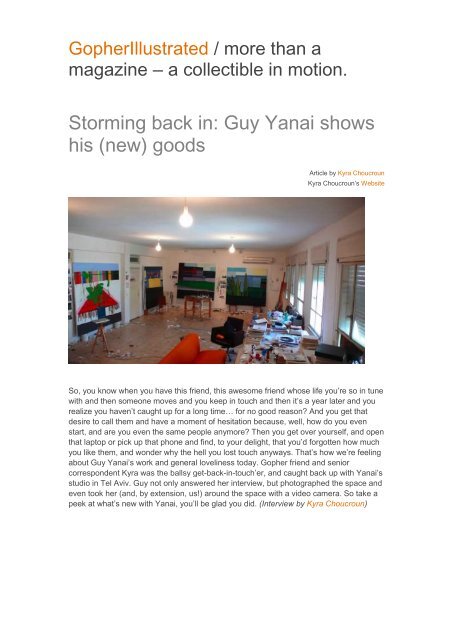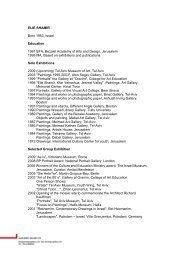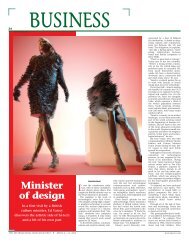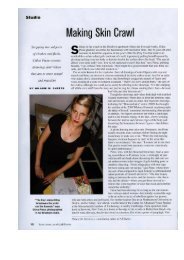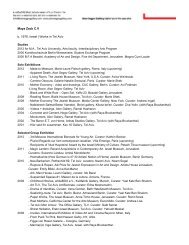Storming back in: Guy Yanai shows his (new) goods - Alon Segev ...
Storming back in: Guy Yanai shows his (new) goods - Alon Segev ...
Storming back in: Guy Yanai shows his (new) goods - Alon Segev ...
Create successful ePaper yourself
Turn your PDF publications into a flip-book with our unique Google optimized e-Paper software.
GopherIllustrated / more than a<br />
magaz<strong>in</strong>e – a collectible <strong>in</strong> motion.<br />
<strong>Storm<strong>in</strong>g</strong> <strong>back</strong> <strong>in</strong>: <strong>Guy</strong> <strong>Yanai</strong> <strong>shows</strong><br />
<strong>his</strong> (<strong>new</strong>) <strong>goods</strong><br />
Article by Kyra Choucroun<br />
Kyra Choucroun‟s Website<br />
So, you know when you have t<strong>his</strong> friend, t<strong>his</strong> awesome friend whose life you‟re so <strong>in</strong> tune<br />
with and then someone moves and you keep <strong>in</strong> touch and then it‟s a year later and you<br />
realize you haven‟t caught up for a long time… for no good reason? And you get that<br />
desire to call them and have a moment of hesitation because, well, how do you even<br />
start, and are you even the same people anymore? Then you get over yourself, and open<br />
that laptop or pick up that phone and f<strong>in</strong>d, to your delight, that you‟d forgotten how much<br />
you like them, and wonder why the hell you lost touch anyways. That‟s how we‟re feel<strong>in</strong>g<br />
about <strong>Guy</strong> <strong>Yanai</strong>‟s work and general lovel<strong>in</strong>ess today. Gopher friend and senior<br />
correspondent Kyra was the ballsy get-<strong>back</strong>-<strong>in</strong>-touch‟er, and caught <strong>back</strong> up with <strong>Yanai</strong>‟s<br />
studio <strong>in</strong> Tel Aviv. <strong>Guy</strong> not only answered her <strong>in</strong>terview, but photographed the space and<br />
even took her (and, by extension, us!) around the space with a video camera. So take a<br />
peek at what‟s <strong>new</strong> with <strong>Yanai</strong>, you‟ll be glad you did. (Interview by Kyra Choucroun)
When we <strong>in</strong>terviewed you for the first time, we asked you how you would describe<br />
your art to a bl<strong>in</strong>d person. Has that changed?<br />
There is the famous l<strong>in</strong>e from the Little Pr<strong>in</strong>ce (That Jose Saramago so brilliantly used <strong>in</strong><br />
The Gospel Accord<strong>in</strong>g to Jesus Christ) “It is only with the heart that one can see” That‟s<br />
the great paradox of be<strong>in</strong>g a visual artist. I guess my articulation has become sharper.<br />
I‟m more aware of how a pa<strong>in</strong>t<strong>in</strong>g of m<strong>in</strong>e is built up <strong>in</strong> the conceptual realm. I can say<br />
now that what <strong>in</strong>terests me is what Susan Sontag called “an emotional situation”,<br />
sensuality, sexuality, feel<strong>in</strong>g. T<strong>his</strong> is supported by the concept of the work, the l<strong>in</strong>guistics<br />
of the work, and usually t<strong>his</strong> adds layers and layers of mean<strong>in</strong>gs. The best work excites<br />
me emotionally and <strong>in</strong>tellectually. Thats what I am striv<strong>in</strong>g for.
There are big differences between your previous work (Objects/Homages), which<br />
we featured <strong>in</strong> August 2009. Can you tell us why it changed? Was it<br />
someth<strong>in</strong>g with<strong>in</strong> you or extraneous circumstances shift<strong>in</strong>g your artistic style?<br />
I‟m always try<strong>in</strong>g to challenge myself, to put a leg out and make myself trip. I am most<br />
comfortable when Im <strong>in</strong> discomfort. I don‟t have a comfort zone of any k<strong>in</strong>d. Everyth<strong>in</strong>g is<br />
anxiety. Objects / Homages is from 2007. After two years of work<strong>in</strong>g abstract I wanted<br />
someth<strong>in</strong>g more concrete to hold onto. These latest works are very large l<strong>in</strong>ens. I had<br />
just f<strong>in</strong>ished and shown a project of 42 small panels on wood, and wanted to do large<br />
work. If you look at the evolution of the work from 2007 to 2010 you see that it‟s a slow<br />
one and might make more sense.
You have two beautiful children. Do you f<strong>in</strong>d it changes your art? In what way?<br />
My children have had such a positive effect. Ava is still really small, but Romy has made<br />
me look at th<strong>in</strong>gs <strong>in</strong> such a fresh way. The questions he asked, and the way he sees the<br />
world really <strong>in</strong>spire me. I would like to be able to look at th<strong>in</strong>gs <strong>in</strong> the same way with the<br />
knowledge that I have. Ma<strong>in</strong>ly, though, Romy tells me what to pa<strong>in</strong>t: a boat, a car, and<br />
airplane, animals etc. And I listen to him. I‟m about to start a project of 10 large panels<br />
just on the questions he asks me. I th<strong>in</strong>k that there is the highest level of sop<strong>his</strong>tication <strong>in</strong><br />
these questions and I hope to be able to mirror that <strong>in</strong> the work. But yes, Ava and Romy<br />
have brought me a re<strong>new</strong>ed sense of urgency and a greater hunger for work.<br />
Imag<strong>in</strong>e yourself as one branch <strong>in</strong> a “family tree” of artists. Who makes up other<br />
branches? Who is part of the trunk?*<br />
I do see myself <strong>in</strong> that way, a part of the big family of art. The trunk is made of (and t<strong>his</strong><br />
not dim<strong>in</strong>ish the hundreds of artist and pa<strong>in</strong>ters that I absolutely love) Piero della<br />
Francesca and Henri Mattise. These are two people who I th<strong>in</strong>k of every day. Really a<br />
<strong>back</strong>bone, and creators of such profound work that I go <strong>back</strong> to thousands of times. The<br />
branches are filled and are dense with many green green leaves. Tal R, Philip Guston,<br />
Willem de Koon<strong>in</strong>g, Wolfgang Tillmans, Olivier Zahm, Walker Evans, Nicole Eisenman,<br />
Dana Schutz, Picasso, Masaccio, Titian, David Hockney, Howard Hodgk<strong>in</strong>, Jonas Wood,<br />
Mark Grotjahn, Cezanne, just to name a few of MANY that came to my head. But most of<br />
my <strong>in</strong>spiration <strong>in</strong> the past years has come from films, fashion, photography, architecture,<br />
design. Charles and Ray Eames absolutely make me go crazy. Herzog and de Meuron<br />
are <strong>in</strong> my m<strong>in</strong>d, the best architectural practices work<strong>in</strong>g today; every solution is particular<br />
and local. The three pillars to my th<strong>in</strong>k<strong>in</strong>g though are: John Zorn, Jean Luc Godard, and<br />
Paul Celan. A composer, A film maker, and a poet. I‟ve been utterly obsessed with all<br />
three of these for so long. John Zorn taught me thats its possible to choose any „style‟<br />
you want. That we can go <strong>in</strong> and out of styles and make them or own, that to choose one<br />
way of work<strong>in</strong>g (and it is a choice) is a lie. That each project can have its own lexicon and<br />
rules. J.L Godard‟s work is constantly chang<strong>in</strong>g, still today. The first time I watched<br />
Histoire du C<strong>in</strong>ema I cried. The density of <strong>in</strong>formation is brilliant. He sort of an editor of<br />
film and art, someth<strong>in</strong>g that resonates highly with me. Paul Celan wrote <strong>in</strong> a language<br />
(German) that most of audience wouldn‟t read <strong>in</strong>. Years ago, I sat with the person who<br />
was organiz<strong>in</strong>g the Hebrew translation from the Israel Foreign office. He told me that<br />
Celan wanted each poem <strong>in</strong> German beside the Hebrew and the Israel Foreign Office<br />
was not allowed to that <strong>in</strong> the 60‟s because of the sensitivity around the German<br />
language then. The way Celan constructed, de-constructed, and re-constructed language<br />
has an immense affect on how I th<strong>in</strong>k pictorially.
What do you consider your personal place <strong>in</strong> society to be? Do you even believe <strong>in</strong><br />
the concept of a „society‟? Does it affect your art?<br />
Society is complex, with many people hav<strong>in</strong>g multitudes of associations, identities, and<br />
ideologies. National and religious identities have, <strong>in</strong> the west, become almost secondary<br />
<strong>in</strong> importance. I can understand why Margaret Thatcher said “There is no society, there<br />
are only <strong>in</strong>dividuals”, but I disagree with her. And hav<strong>in</strong>g said that, most of the time, I feel<br />
rather removed from society, a sort of distant observer. T<strong>his</strong> is true of Israeli society, and<br />
its true of American society, and def<strong>in</strong>itely true of European society. Because of t<strong>his</strong><br />
distance (that is not self-forced) I can take, steal, use, render, <strong>in</strong>terpret, and do whatever<br />
I want with all of the <strong>in</strong>formations that come from all societies. It gives me a freedom to<br />
become a grand editor. The price is lonel<strong>in</strong>ess.<br />
* t<strong>his</strong> question courtesy of t<strong>his</strong> site


